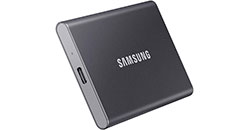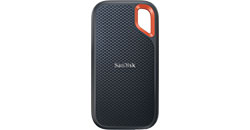Comparison of external SSD best sellers – SSD recommendations and shopping tips
Western Digital
WD My Passport SSD
- best buy external SSD
- 500 GB to 4 TB (4,000 GB)
- up to 1,050 MB/s
- 100.0 mm x 55.1 mm x 8.9 mm
- 5 years limited warranty
Samsung
Portable SSD T7
- best buy external SSD
- 500 GB to 2 TB (2,000 GB)
- up to 1,050 MB/s
- 85.0 mm x 57.0 mm x 8.0 mm
- 3 years limited warranty
SanDisk
Extreme Portable SSD V2
- best buy external SSD
- 500 GB to 4 TB (4,000 GB)
- up to 1,050 MB/s
- 100.5 mm x 52.4 mm x 8.9 mm
- 5 years limited warranty
shop around for best external SSD worldwide on | Amazon.com #ad | computeruniverse.net | eBay.com | AliExpress.com |
- ADS -
What is an external SSD?
An external SSD is an SSD that is intended for external, system-independent and mobile use. Thus, an external SSD can be used for data backup or the transfer of large amounts of data. For the connection to the desktop PC or laptop, the USB interface is usually used, ideally in the most modern and powerful version. The external drive is also powered via the USB cable. There are no standards for the external dimensions, so manufacturers have a free hand in designing their external SSD hard drives.
What are the advantages of an external SSD?
The external SSDs are perfectly suited for both stationary use to create large backups and for mobile use to copy many or large data from one computer to another. Compared to external HDD hard disks, the external SSDs offer in some cases significantly better read and write performance. Compared to USB sticks, also equipped with flash memory, the external SSDs allow higher capacities, which can be a clear advantage in view of the increasing data volumes.
What are the disadvantages of an external SSD?
One disadvantage of external SSDs is the relatively high price per gigabyte. Thus, external hard disks with a built-in HDD can be a more cost-effective alternative for archiving large amounts of data when writing or reading the drive as quickly as possible is not necessarily important. If the high capacity of an external SSD is not required, a USB stick may be the cheaper option for data transfer. Furthermore, the USB interface used by the manufacturer (generations older than USB 3.1) can create a bottleneck, so that the built-in SSD is not brought to its maximum performance in practice.
For whom is an external SSD the right choice?
An external SSD is the right purchase tip and recommendation for every user for whom the advantages of an external SSD represent added value despite a higher price per gigabyte. There are certainly examples of applications where an external SSD can make full use of its features. On the one hand, there would be the regular backups of large amounts of data, which have to be carried out in the shortest possible time. On the other hand, an external SSD can be used as a mobile device to transport many and even huge files, such as 4K video material, between several computers. With the help of an appropriate housing, any SSD hard disk, even an older one from a retired system, can be used as an external drive.


